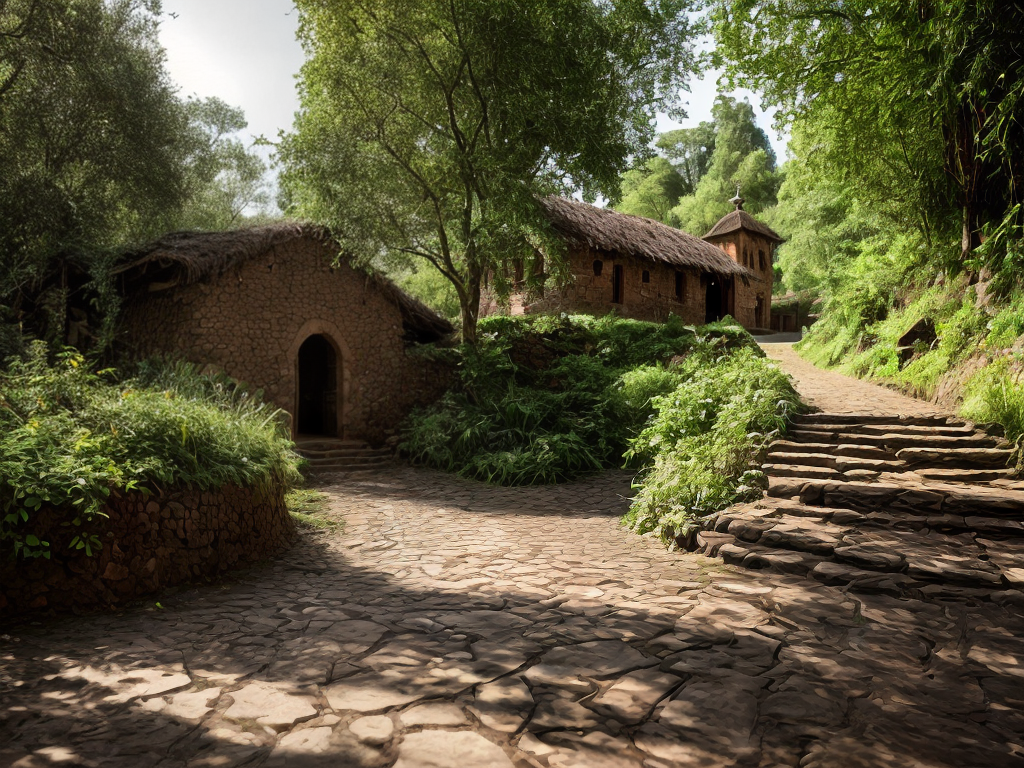As I stepped into the ancient world of Lalibela, I felt a wave of awe wash over me. The air was thick with the mystique of centuries-old secrets and the scent of incense. In this guide, I will take you on a journey through the captivating rock-hewn churches of Lalibela. From their rich history to the intricate architecture, we will explore the hidden gems and experience the profound religious rituals that make this place truly extraordinary.
History of Lalibela’s Rock-Hewn Churches
In my visit to Lalibela’s Rock-Hewn Churches, I was fascinated by the rich history surrounding these ancient structures. The history of Lalibela’s religious practices dates back to the 12th century when King Lalibela ruled over the Kingdom of Ethiopia. Legend has it that Lalibela was divinely inspired to construct these churches as a “New Jerusalem” in order to bring Christianity closer to the people. The rock-hewn churches hold immense cultural significance as they are not only places of worship but also architectural marvels. They showcase the extraordinary craftsmanship and ingenuity of the people of Lalibela who carved these churches out of solid rock using only hand tools. These churches have become a symbol of Ethiopian identity and a testament to the enduring faith and artistic skills of the Ethiopian people.
Architecture and Design of the Churches
When it comes to the architecture and design of the rock-hewn churches of Lalibela, their uniqueness is immediately apparent. These churches, carved entirely out of solid rock, showcase a distinct Ethiopian style of church architecture. What sets them apart is not just their construction, but also the symbolism embedded in their design, reflecting the deep religious and cultural beliefs of the Ethiopian Orthodox Church.
Unique Ethiopian Church Architecture
During my visit to the mystical rock-hewn churches of Lalibela, I was captivated by the unique architecture and design of these Ethiopian churches. The Ethiopian church traditions are deeply rooted in the cultural significance of Lalibela’s churches, which are considered sacred places of worship. The churches are carved out of solid rock, with each one having its own distinct design and layout. Some are shaped like crosses, while others resemble monolithic structures. The intricate carvings and detailing on the walls, pillars, and ceilings showcase the exquisite craftsmanship of the artisans who created these masterpieces. The churches are interconnected by a network of tunnels and passageways, adding to their mystique. It is truly remarkable to witness how these churches have stood the test of time, serving as a testament to the rich architectural heritage of Ethiopia.
Symbolism in Church Design
As I explore the mystical rock-hewn churches of Lalibela, the symbolism embedded in their architecture and design becomes apparent. These ancient structures are not just buildings, but intricate works of religious art that convey deep spiritual messages. The hidden meanings in church architecture are a testament to the faith and devotion of the people who built them.
One prominent example of symbolism can be seen in the use of crosses in the churches of Lalibela. These crosses are not mere decorative elements, but powerful symbols of Christianity. They represent the crucifixion of Jesus Christ and the ultimate sacrifice he made for humanity’s salvation. The intricate carvings and patterns on the crosses further enhance their symbolic significance.
Another important aspect of the church design is the use of geometric shapes and patterns. These patterns often follow a strict symmetry, representing balance and harmony. The repetition of shapes such as circles and squares symbolizes the cyclical nature of life and the eternal presence of God.
In addition to geometric symbolism, the layout of the churches also holds deeper meanings. Each church is interconnected through a network of tunnels and passageways, creating a pilgrimage-like experience for visitors. This layout represents the spiritual journey of believers, leading them closer to God as they navigate through the sacred spaces.
The use of light and darkness is yet another symbolic element in church design. The dimly lit interiors create an atmosphere of reverence and mystery, allowing worshippers to focus on their spiritual connection. Light, on the other hand, symbolizes divine presence and enlightenment.
Exploring the Main Cluster of Churches
I explored the main cluster of churches in Lalibela, marveling at the intricate rock-hewn structures. As I ventured into these ancient places of worship, I couldn’t help but be captivated by their hidden chambers, each one holding a unique story waiting to be discovered. The preservation efforts undertaken here were commendable, as these churches have stood the test of time for over 800 years. The delicate carvings on the walls and ceilings were still intact, displaying the incredible craftsmanship of the medieval Ethiopian artisans. It was awe-inspiring to witness the devotion and dedication that went into constructing these sacred spaces. As I explored further, I couldn’t help but feel a deep sense of reverence for the spiritual significance of these churches, and the rich history they represented.
Lesser-Known Rock-Hewn Churches to Discover
While exploring the main cluster of churches in Lalibela, I discovered a number of lesser-known rock-hewn churches that are waiting to be explored. These hidden gems offer a unique and intimate experience for visitors seeking a deeper connection with the religious history of the region. One such church is St. Gabriel’s, tucked away from the bustling crowds. Inside, I was amazed to find secret chambers adorned with ancient frescoes depicting biblical scenes. The intricate carvings and detailed artwork were a testament to the skill and devotion of the craftsmen who built these churches centuries ago. Another lesser-known church is St. George’s Twin, a smaller replica of the iconic St. George’s Church. This hidden treasure boasts its own secret chamber, filled with stunning murals and a peaceful atmosphere. Exploring these lesser-known rock-hewn churches truly added another layer of wonder to my visit to Lalibela.
Religious Significance and Rituals at Lalibela
As I stepped into the rock-hewn churches of Lalibela, I could feel the weight of ancient Christian practices and rituals. The air was thick with spirituality, and I found myself immersed in a unique spiritual experience. The architectural design of these churches held deep symbolism, reflecting the faith and devotion of the people who built them.
Ancient Christian Practices
One significant aspect of the mystical rock-hewn churches of Lalibela is the rich religious significance and ancient rituals that can be observed within them. These ancient Christian practices hold deep spiritual significance for the people of Lalibela and offer a glimpse into their devout faith. The rock-hewn churches serve as sacred spaces where these rituals have been performed for centuries, fostering a strong sense of community and connection to the divine. The rituals themselves vary, but some common practices include chanting of hymns, lighting of candles, and the offering of prayers. These rituals not only provide a sense of continuity with the past but also serve as a means of seeking spiritual enlightenment and divine intervention. The ancient Christian rituals at Lalibela are a testament to the enduring power of faith and the profound impact it has on the lives of the people who practice it.
Unique Spiritual Experiences
I was captivated by the unique spiritual experiences I encountered at the rock-hewn churches of Lalibela, where the religious significance and rituals truly immersed me in the profound faith of the community. As a destination for spiritual tourism, Lalibela’s cultural heritage is deeply rooted in its ancient Christian practices. The rock-hewn churches themselves are a testament to the devotion and craftsmanship of the people who built them. Each church has its own rituals and ceremonies, adding to the spiritual atmosphere of the place. One of the most memorable experiences for me was witnessing the Timket celebration, a vibrant and colorful religious festival that commemorates the baptism of Jesus. The chanting, drumming, and dancing created an electric energy that filled the air, connecting everyone present to a higher power.
| Unique Spiritual Experiences | Religious Significance and Rituals at Lalibela |
|---|---|
| Ancient Christian Practices | Deeply rooted in Lalibela’s cultural heritage |
| Timket Celebration | Commemorates the baptism of Jesus |
| Vibrant and Colorful | Chanting, drumming, and dancing |
| Electric Energy | Connects everyone present to a higher power |
| Profound Faith | Immersed in the spiritual atmosphere |
Symbolism in Architectural Design
During my visit to the rock-hewn churches of Lalibela, I was intrigued by the symbolism in the architectural design, which holds deep religious significance and plays a vital role in the rituals practiced at this sacred site. The hidden meanings behind the intricate carvings and structures reveal a spiritual significance that transcends the physical realm. Here are some key aspects of the symbolism in the architectural design at Lalibela:
- The cross-shaped layout of the churches represents the crucifixion of Jesus Christ and serves as a reminder of his sacrifice.
- The underground passages and tunnels symbolize the journey to the afterlife and the soul’s progression towards salvation.
- The intricately carved windows and doors showcase the connection between the earthly and divine realms, allowing worshippers to commune with God.
These symbolic elements create a profound and immersive experience, inviting visitors to connect with their spirituality and engage in ancient rituals that have been practiced for centuries.
Practical Tips for Visiting Lalibela’s Churches
When planning a trip to Lalibela’s rock-hewn churches, it is essential to consider some practical tips for a smooth visit. First and foremost, it is important to adhere to visitor etiquette when exploring these sacred sites. Respectful behavior, such as dressing modestly and refraining from loud conversations or photography inside the churches, is greatly appreciated. Additionally, engaging the services of a local guide can greatly enhance your experience. These knowledgeable guides can provide valuable insights into the history, symbolism, and significance of each church, ensuring that you don’t miss out on any important details. They can also help navigate the narrow passageways and point out hidden gems that might otherwise go unnoticed. So, make sure to embrace the local expertise and hire a guide to make the most of your visit to Lalibela’s mystical rock-hewn churches.







